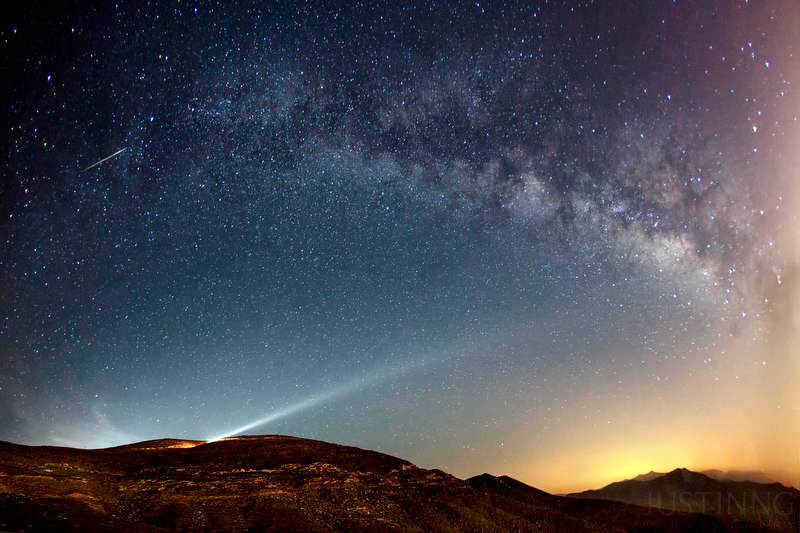The first ever Camelopardalids Meteor Shower ended up being more of a drizzle than a shower, said astrophotographer
John Chumack
. "The new shower had very few meteors per hour, I estimated about 8 to 12 per hour, most were faint, but it did produce a few bright ones, as seen captured by my Meteor Video Camera network at my backyard observatory in Dayton Ohio."
The above image is by
Justin Ng
who went to Jebel Al Jais mountain near Dubai to capture the meteor shower.
As our own
Bob King reported the morning after
-- with several images and apt descriptions of the shower -- the peak activity seem to occur around 2:00am to 4:00am EST (0700 to 900 UT).
There was a lot of buzz about a weird gigantic persistent train that occurred early on (about 1 am EST) and it ended up being a cameo appearance by the Advanced Land Observation Satellite a new Japanese mapping satellite, and a fuel dump from a booster stage of the satellite's launch vehicle. Read more about it at
Bob's article,
and see some images of it below.
Also, see a great video capture of a persistent train, shot by astrophotographer Gavin Heffernan:
We've had some more images come in via email and on
our Flickr page
Persistent trains are the vaporized remains of the tiny meteoroid. The dust is blown around by upper level winds in Earth's atmosphere.
Here's a great time-lapse of the plume from the fuel dump
. Astrophotographer Alan Dyer called it a "strange glow of light that moved across the northern sky... What I thought was an odd curtain of slow-moving, colourless aurora — and I've seen those before — has many people who also saw it suspecting it was a glow from a fuel dump from an orbiting satellite.
This short time-lapse of 22 frames covers about 22 minutes starting at 11:59 pm MDT on May 23 Each frame is a 60-second exposure taken at 2 second intervals, played back at one frame per second.
[caption id="attachment_112175" align="aligncenter" width="580"]
A Camelopardolids Meteor on May 24, 2014. Credit and copyright: Stephen Rahn. [/caption]
[caption id="attachment_112176" align="aligncenter" width="580"]
Camelopardalids Meteor zips past the Big Dipper and Mars on May 24, 2014. Credit and copyright: John Chumack. [/caption]
Here's a video compilation put together by John Chumack:
[caption id="attachment_112174" align="aligncenter" width="580"]
Closeup of one frame of a timelapse session containing what appears to be a meteor from the
Camelopardalids meteor shower. Credit and copyright: DaretheHair on Flickr. [/caption]
[caption width="580" align="alignnone"]
An animated gif of the strange 'cloud' plume from a fuel dump from the launch of a new Japanese mapping satellite. Credit and copyright: DaretheHair. [/caption]
We'll add more images as they come in!
Want to get your astrophoto featured on Universe Today? Join our Flickr group or send us your images by email (this means you're giving us permission to post them). Please explain what's in the picture, when you took it, the equipment you used, etc.
 Universe Today
Universe Today
